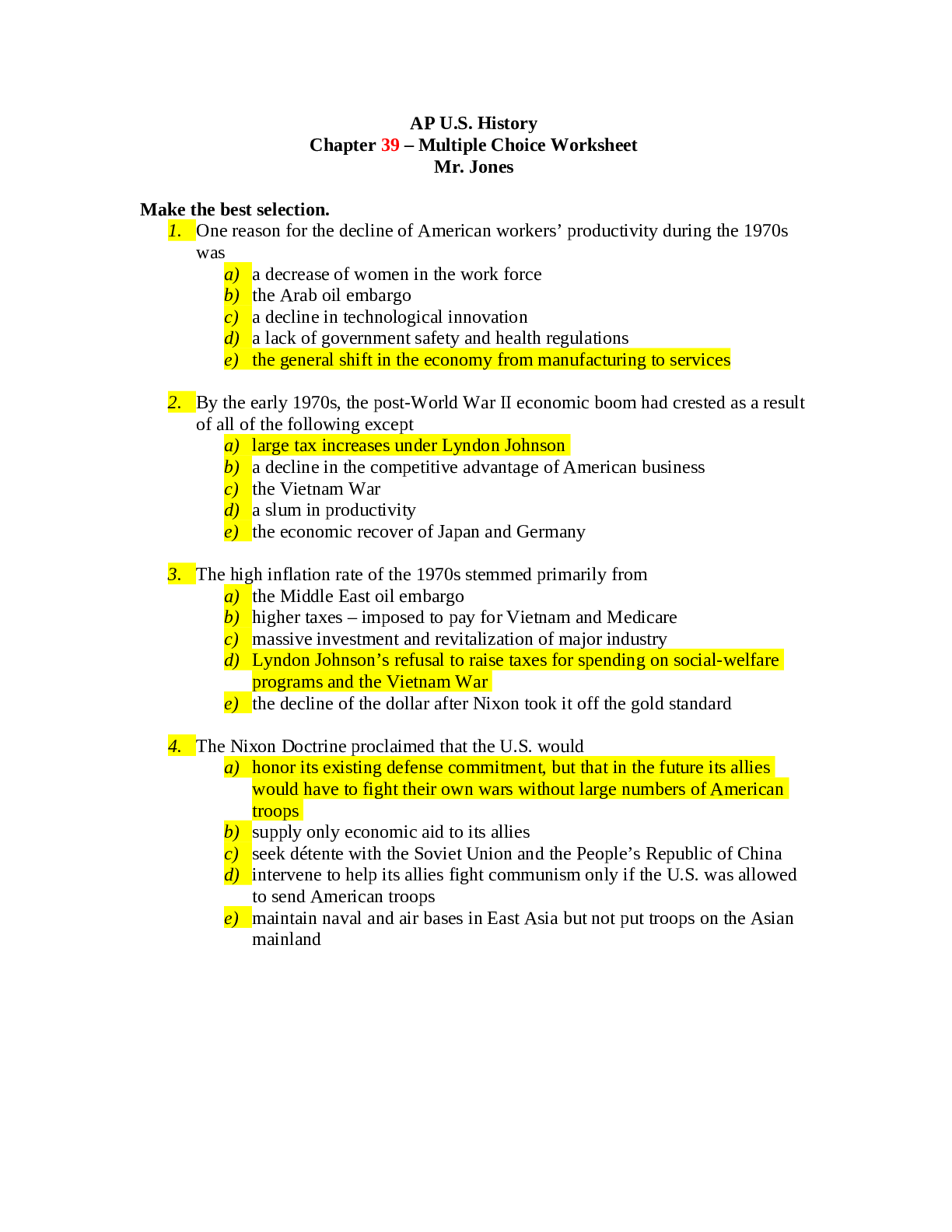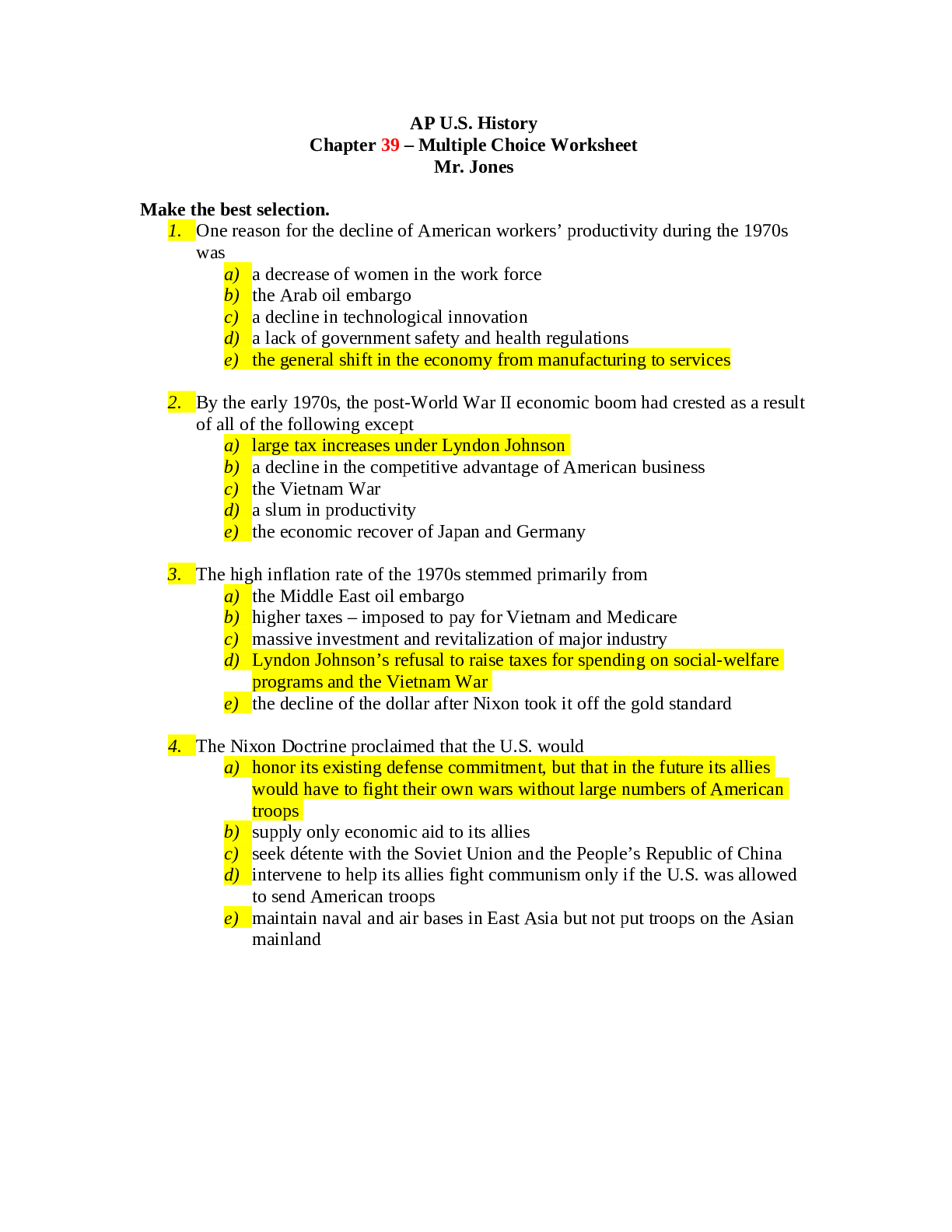AP U.S. History
Chapter 39 – Multiple Choice Worksheet
Mr. Jones
Make the best selection.
1. One reason for the decline of American workers’ productivity during the 1970s
was
a) a decrease of women in the work force
b) the Arab oil embargo
c) a decline in technological innovation
d) a lack of government safety and health regulations
e) the general shift in the economy from manufacturing to services
2. By the early 1970s, the post-World War II economic boom had crested as a result
of all of the following except
a) large tax increases under Lyndon Johnson
b) a decline in the competitive advantage of American business
c) the Vietnam War
d) a slum in productivity
e) the economic recover of Japan and Germany
3. The high inflation rate of the 1970s stemmed primarily from
a) the Middle East oil embargo
b) higher taxes – imposed to pay for Vietnam and Medicare
c) massive investment and revitalization of major industry
d) Lyndon Johnson’s refusal to raise taxes for spending on social-welfare
programs and the Vietnam War
e) the decline of the dollar after Nixon took it off the gold standard
4. The Nixon Doctrine proclaimed that the U.S. would
a) honor its existing defense commitment, but that in the future its allies
would have to fight their own wars without large numbers of American
troops
b) supply only economic aid to its allies
c) seek détente with the Soviet Union and the People’s Republic of China
d) intervene to help its allies fight communism only if the U.S. was allowed
to send American troops
e) maintain naval and air bases in East Asia but not put troops on the Asian
mainland
Page 2.
5. Perhaps Nixon’s most valuable asset as he began his presidency in 1969 was his
a) naturally conciliatory manner
b) inclination to try to work openly with antiwar liberals to halt the Vietnam
War
c) close connection with former President Eisenhower
d) clear mandate from the public as a result of his 1968 election victory
e) expertise in foreign affairs
6. President Nixon’s policy of “Vietnamization” of the war in Vietnam called for
a) a gradual handover of the ground war to the South Vietnamese
b) a full-scale conventional invasion of North Vietnam
c) reorganization of the American army in Vietnam into anti-guerilla units
d) an end to all American military and economic aid to South Vietnam
e) a de-emphasis on military assaults in favor of Vietnamese social reform
7. Richard Nixon’s Vietnam policy included all of the following except
a) Vietnamization
b) extension of the war to Cambodia
c) massive bombing campaigns in Vietnam
d) increased American troop commitments
e) creating a draft lottery and reducing draft calls
8. The American armed forces in Vietnam were composed largely of
a) marines
b) African-Americans
c) soldiers in their mid-twenties
d) the least privileged young Americas
e) professional career soldiers
9. The _______________ Amendment __________________ the voting age to
_________________.
a) 26th, raised, 21
b) 24th, lowered, 18
c) 25th, raised, 19
d) 26th, lowered, 18
e) 26th, lowered, 16
10. The Pentagon Papers, published in 1971,
a) revealed President Nixon’s role in the Watergate scandal
b) documented the North Vietnamese attack in the Gulf of Tonkin
c) exposed President Nixon’s secret bombing war of Cambodia
d) was the first that the American public knew of the Nixon Doctrine
e) exposed the deception that had led the U.S. into the Vietnam War
Page 3.
11. President Nixon’s chief foreign-policy adviser was
a) Henry Kissinger
b) Daniel Ellsberg
c) Spiro Agnew
d) Cyrus Vance
e) Donald Rumsfeld
12. Richard Nixon’s policy of détente
a) was designed to improve relations between the Soviet Union and China
b) was aimed at ending the division of Germany and Korea
c) was a failure
d) found support in the Democratic party but not the Republican party
e) ushered in an ear of relaxed tensions between the U.S. and the two leading
communist powers, China and the Soviet Union
13. The decisions of the Supreme Court under Chief Justice Earl Warren reflected its
a) desire for legalized abortions
b) support for states’ rights
c) support for expanding federal power
d) deep concern for the individual
e) hostility to religion
14. In Griswold vs. Connecticut, the Supreme Court upheld a married couple’s right
to use contraceptives based on
a) the “necessary and proper” clause
b) the First Amendment
c) the right to privacy
d) Roe vs. Wade
e) the Fifth Amendment
15. Critics of the Supreme Court under Chief Justice Earl Warren complained that the
Court
a) would not support the reapportionment of state legislatures
b) was ignoring the Constitution in favor of its own social values
c) actually requested the most controversial cases available
d) changed its philosophical perspective too frequently
e) was too deferential to Congress and state legislatures
16. When it came to welfare programs, Richard Nixon
a) sought to exclude African-Americans
b) tried to repeal only food stamps and Medicaid
c) did little to reduce the poverty rate
d) did his best to do away with Lyndon Johnson’s Great Society programs
e) supported significant expansion in many areas
Page 4.
17. Richard Nixon’s Philadelphia Plan
a) was a direct attack on affirmative action
b) aimed at giving direct economic assistance to business
c) attempted to counter the Supreme Court’s opposition to affirmative action
d) required construction trade unions to establish timetables and goals for
hiring black apprentices
e) aimed to renovate inner cities like those in Philadelphia
18. The difference between Lyndon Johnson’s affirmative action programs and those
of Richard Nixon was
a) very small
b) that Johnson intended his to help groups and Nixon intended his to help
individuals
c) that Nixon’s actions applied only to educational opportunities and did
nothing for employment, while Johnson’s helped both
d) that Johnson intended to help individuals, but Nixon conferred privileges
on groups
e) that Johnson established quotas and Nixon ended them
19. All of the following are legacies of Richard Nixon’s presidency except
a) the Environmental Protection Agency
b) Supplemental Security Income for the blind, disabled, and indigent aged
c) the Endangered Species Act
d) the Occupational Health and Safety Administration
e) the Food Stamp program
20. To control creeping inflation in the early 1970s, President Nixon
a) imposed a ninety-day wage-and-price freeze
b) put the U.S. back on the gold standard
c) sought a system of international currency stabilization
d) lowered Social Security payments
e) pressured the Federal Reserve Board to raise interest rates
21. As president, Richard Nixon succeeded in
a) completely overhauling the welfare system
b) ending affirmative action
c) keeping Congress from imposing a wage-and-price freeze to combat
inflation
d) keeping the U.S. on the gold standard
e) implementing the Supplemental Security Income program
Read More


